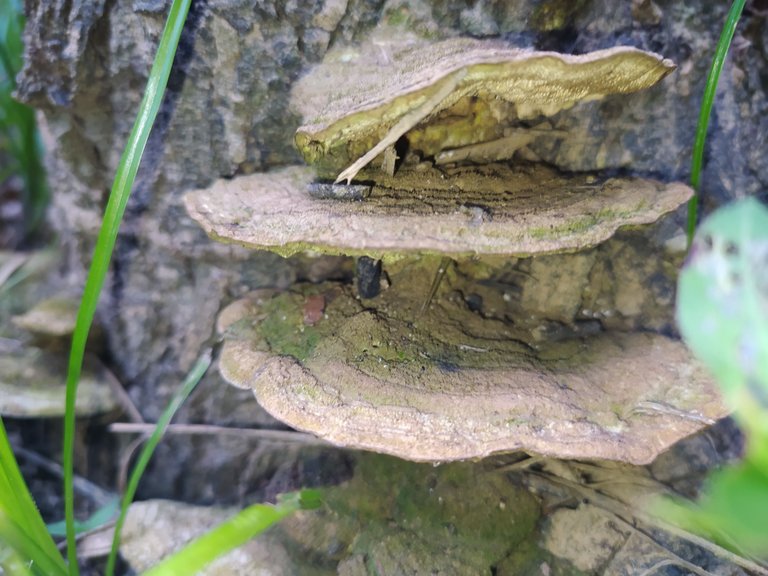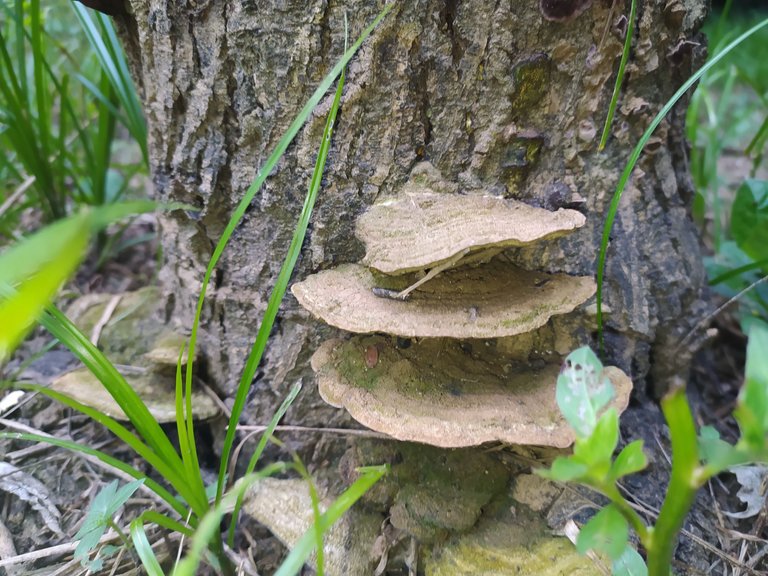Los Hongos, Agárico blanco🍄. (Esp-Eng)
#AmazingNature competencia organizada por @bucipuci
Tema: Los Hongos.
Aquí, puedes encontrar más información sobre el concurso.
Saludos naturales a esta comunidad de #AmazingNature que me da la oportunidad de dar a conocer las bellezas naturales que puedo disfrutar a mi alrededor y me inspira día a día.
Es muy interesante el mundo de los hongos, hace unos días un amigo biólogo colocó una gran variedad en las redes, no solo en forma, sino también en colores.
Algunas personas los ven como algo malo sobre la tierra, por el contrario es interesante conocer su mundo .

Los beneficios que trae en cuanto a la descomposición de desecho, actuando como un purificador del suelo.
En cuanto ví el desafío, estuve buscando por todos lados, alguna de las especies de hongos y sorpresa conseguí esta pequeña colonia de Agárico blanco y su nombre científico es , Polyporus officinalis.
Esta especie creció muy cerca , podría decir que casi al bode de una laguna que durante el periodo de lluvia se desbordó, haciendo de este lugar especialmente ideal para su crecimiento.



El agárico blanco, Polyporus officinalis, es un tipo de hongo medicinal de color blanco el cual se puede encontrar con facilidad en zonas boscosas y húmedas.
El género de los Polyporus comprende una gran variedad de hongos los cuales pueden crecer a nivel de suelo o en árboles, en el artículo nos centraremos en la especie officinalis aunque es importante señalar que muchos de los hongos de este género tienen usos medicinales y nutritivos.
Descripción
Los sombreros aparecen a lo largo del tronco de los arboles anteriormente citados; no se sujetan con nada, simplemente se ve una forma redondeada sin rabillo. Son carnosos y se encuentran protegidos por una piel gruesa y con surcos. Su olor recuerda al de otras setas cuando están frescas, pero al secarse huelen como el moho.
El Agárico blanco se cría en los cedros del norte de áfrica y en los alerces, arboles coníferos que no se hallan en la Península Ibérica.
El agárico blanco es un hongo y por tanto no tiene ni flores ni época de floración. La base vegetativa de los hongos esta constituida por el micelio; este aparece formado por una serie de hebrillas que se alargan bajo tierra y que se unen al pie de la seta propiamente dicha. Esta parte se mantiene todo el año.
El aparato reproductor del agárico blanco lo constituye la seta. Las laminillas que hay en el sombrero contienen esporas.
Se recolecta el sombrero del agárico blanco, y nada mas hacerlo se le quita la corteza y se corta en pedazos para su posterior desecación. Se coloca en lugar de poca humedad y, una vez seco, se guarda en frascos bien cerrados para su conservación.
Hábitat y distribución
El Agárico blanco no se encuentra en la Península Ibérica. Se cría en los cedros del norte de África y en los alerces, árboles coníferos que no se hallan en España.
Propiedades medicinales
Se destacan tres efectos de interés medicinal del Agárico blanco:
Hipoidrosis: Que provoca una sudoración disminuida al provocar una parálisis temporal en las glándulas sudoríparas.
Laxante y purgante: En dosis más elevadas puede auxiliar en problemas de estreñimiento y para de purificación del cuerpo.
Anteriormente se usaba con otros fines como la desintoxicación del hígado, asistir en problemas de asma, y también como tratamiento de la ictericia, sin embargo, muchos de estos efectos no se han probado y hoy en día su principal uso es como antisudorífico.
Usos
Cocimiento. Se coloca 1 gramos de Agárico blanco a hervir en un litro de agua y posteriormente se deja enfriar. Para reducir la sudoración se debe de tomar una taza después de la comida, se puede endulzar con miel o azúcar. Para hacer laxantes o purgas se incrementa a 2 o 3 gramos de hongo por litro de agua.
Es muy interesante descubrir las propiedades de este hongo, que parecía un intruso sobre el tronco y resultó ser un muy curioso tesoro, lleno de propiedades medicinales.
La invitación es a no, desestimar a los hongos, solo por su aspecto, claro hay que tener cuidado con algunos que suelen ser venenosos.
Espero que al igual que yo, les parezca interesante esta información, sobre este hongo que encontré en un hermoso lugar que visito con mucha frecuencia .
Saludos Naturales.🍃


Mushrooms, White agaric🍄
#AmazingNature competition organized by @bucipuci.
Topic: Fungi.
Here, you can find more information about the competition.
Natural greetings to this #AmazingNature community that gives me the opportunity to make known the natural beauties that I can enjoy around me and inspires me day by day.
It is very interesting the world of mushrooms, a few days ago a biologist friend of mine posted a great variety in the networks, not only in shape, but also in colors.
Some people see them as something bad on earth, on the contrary it is interesting to know their world.

The benefits it brings in terms of waste decomposition, acting as a soil purifier.
As soon as I saw the challenge, I was looking everywhere for some of the species of fungi and surprise I got this small colony of white agaric and its scientific name is Polyporus officinalis.
This species grew very close, I could say that almost at the edge of a lagoon that during the rainy season overflowed, making this place especially ideal for its growth.



The white agaric, Polyporus officinalis, is a type of white medicinal mushroom that can be easily found in wooded and humid areas.
The Polyporus genus comprises a wide variety of mushrooms which can grow at ground level or on trees, in the article we will focus on the species officinalis although it is important to note that many of the mushrooms in this genus have medicinal and nutritional uses.
Description
The caps appear along the trunk of the aforementioned trees; they are not attached to anything, you simply see a rounded shape without a corner. They are fleshy and are protected by a thick, furrowed skin. Their odor is reminiscent of other mushrooms when fresh, but when dried they smell like mold.
The white agaric grows on North African cedars and larch trees, coniferous trees that are not found on the Iberian Peninsula.
The white agaric is a fungus and therefore has neither flowers nor flowering time. The vegetative base of the mushrooms is constituted by the mycelium; this appears formed by a series of hebrillas that elongate underground and that are united to the foot of the mushroom itself. This part is maintained all year round.
The reproductive apparatus of the white agaric is the mushroom. The lamellae in the cap contain spores.
The cap of the white agaric is harvested and the bark is removed and cut into pieces for subsequent drying. It is placed in a place with low humidity and, once dried, it is stored in tightly closed jars for preservation.
Habitat and distribution
The white agaric is not found in the Iberian Peninsula. It grows in North African cedars and larch trees, coniferous trees that are not found in Spain.
Medicinal properties
Three effects of medicinal interest of the white agaric stand out:
Hypohidrosis: which causes decreased sweating by causing temporary paralysis of the sweat glands.
Laxative and purgative: In higher doses it can help in constipation problems and for purification of the body.
Previously it was used for other purposes such as liver detoxification, to assist in asthma problems, and also as a treatment for jaundice, however, many of these effects have not been proven and today its main use is as an anti-sweating agent.
Uses
Cocimiento. Place 1 gram of white agaric to boil in a liter of water and then let it cool. To reduce sweating, take a cup after a meal, it can be sweetened with honey or sugar. To make laxatives or purges is increased to 2 or 3 grams of fungus per liter of water.
It is very interesting to discover the properties of this fungus, which seemed an intruder on the trunk and turned out to be a very curious treasure, full of medicinal properties.
The invitation is not to underestimate mushrooms, just because of their appearance, of course you have to be careful with some that are usually poisonous.
I hope that like me, you find this information interesting, about this fungus that I found in a beautiful place that I visit very often.
Natural Greetings.🍃

Source
Fotografías y texto propiedad de la autora.
Banner y separadores CC Express.

Congratulations @anamariag! You have completed the following achievement on the Hive blockchain and have been rewarded with new badge(s):
Your next target is to reach 500 replies.
You can view your badges on your board and compare yourself to others in the Ranking
If you no longer want to receive notifications, reply to this comment with the word
STOPCheck out the last post from @hivebuzz:
https://twitter.com/galindez_suarez/status/1573482416567623694
The rewards earned on this comment will go directly to the people sharing the post on Twitter as long as they are registered with @poshtoken. Sign up at https://hiveposh.com.
I appreciate your work and your post has been manually curated by Botanic team @oscurity on behalf of Amazing Nature Community. Keep up the good work!
thanks for sharing
We appreciate your work and your post was manually curated by @none! from the DNA team!
Reach us on Discord to learn more about the project!
Thank you for entering the contest.
Mushrooms are very diverse. They grow even where you wouldn't expect it. It is very fortunate to know mushrooms that have healing properties.
Hi @bucipuci , that's what I felt when reviewing its features, it is very interesting that ecosystem . 👍
:-)
Fungi most interesting in ability to rectify nature and act as healing properties, nice photography and detail.